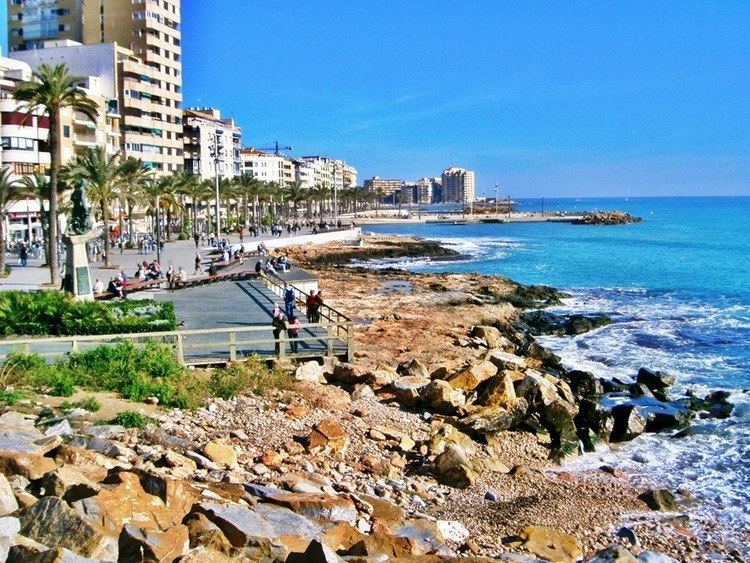Founded 20th century Population 91,415 (2014) | Judicial district Torrevieja Elevation 7 m (23 ft) | |
 | ||
Weather 19°C, Wind E at 14 km/h, 54% Humidity Points of interest Aquopolis Torrevieja, Sociedad Cultural Casino d, Garden of Nations, Museo del Mar y de la Sal, Torre del Moro | ||
Places to see in torrevieja spain
Torrevieja ([toreˈβjexa], Torrevella [toreˈveʎa]) is a seaside city and municipality located on the Costa Blanca in the province of Alicante, in south-eastern Spain.
Contents
- Places to see in torrevieja spain
- Map of Torrevieja Alicante Spain
- The best places of torrevieja
- History
- Climate
- Recent
- Politics
- Population
- Places of interest
- Notable people
- References
Map of Torrevieja, Alicante, Spain
Torrevieja lies about 50 kilometres south of the city of Alicante and has a population of 105,000 (2012). Torrevieja was originally a salt-mining and fishing village as it is located between the sea and two large salt lakes (Las Salinas), which give Torrevieja a healthy microclimate.
The best places of torrevieja
History
Until 1802, Torrevieja existed only as an ancient guard tower, which gave the town its name (Torre Vieja (Spanish) means Old Tower) and some labourers' cottages. But in 1803, Charles IV authorised the movement of the salt production offices from La Mata to the town itself and allowed the construction of dwellings there. In 1829, the town was totally destroyed by an earthquake, but the basins were soon reconstructed and re-opened. In 1931, Alfonso XIII gave Torrevieja city status by special grant. During this period, there was also a growing market for flax, hemp and cotton.
In the 19th century, the salt was mainly shipped from the town by Swedish and Dutch ships. At the time, there was only limited demand from other regions of Spain, mainly Galicia and to a lesser extent, Valencia. Although by the dawn of the 20th century, a quarter of all the salt harvested from the lagoon in Torrevieja was sold in Spain itself, and the rest exported was to foreign markets. Today, it is still an important industry in Torrevieja and a major employer. You can visit the Museum of Sea and Salt.
Climate
Köppen-Geiger climate classification system classifies its climate as hot semi-arid (BSh), barely escaping the hot desert climate by having slightly (ca 10 mm) more precipitation than what is needed to classify it as such.
Recent
In recent years the local economy has hugely expanded due to the tourist industry. This includes both a strong contingent of British, Irish, Germans and Scandinavians, many of whom live there all the year round, and Spanish people who have a second home in the city. By 2004, Torrevieja had the largest number of British residents of all the Spanish municipalities (approx. 7,180) The high number of British expatriates has led to Torrevieja being nicknamed as 'the costa del Yorkshire' by some holidaymakers, often surprised that many British residents prefer imported cheap mass-produced bread from England such as Warburtons and Hovis.
Since 2001, the city's authorities, along with Random House's Spanish subsidiary, Plaza & Janés, award Spain's second most important annual literary award, the Premio de Novela Ciudad de Torrevieja, and its poetry correlative, Premio de Poesía Ciudad de Torrevieja.
Politics
The city is a conservative stronghold, with the Partido Popular maintaining an absolute majority at the municipal elections of 2007, and 2011. PP however narrowly lost its absolute majority in 2015 to a coalition of five parties which designated Green candidate José Manuel Dolón García mayor.
Population
In 1991, the city had 25,000 residents, two decades later close to 100,000. The father of the expansion was Pedro Ángel Hernández Mateo, mayor between 1988 and 2011. In order to encourage growth, all the land was rezoned fit for building, save for the two lagoons, designated natural parks in 1989.
The INE (Spanish Census) of 2005 showed that the city had 84,838 residents, and the ayuntamiento (district council area) had 95,531 residents. By January 2008 this figure had reached 103,154 of whom only 47,870 were Spanish. 7,000+ of the Spanish residents were originally from Madrid and not for nothing is Torrevieja known as "la playa de Madrid" (The Madrid Beach).
The most prominent nationalities in 2012 were:
Historical population of Torrevieja
